
9 DAYS 8 NIGHTS IN INDIA
PART II - LADAKH
(Total expenses at the end of the post)
If you've read my Part I, I'm sure you already know how dramatic my trip was even though it was just 3 days. Finally we got to fly out of the cities and head to the Himalayan part of India - Ladakh. It totally felt like going from one end of the world to the other. From someone who was grumpy and stressed, I immediately turned into a calm and ZENful person being in the mountains and nature in Ladakh, LOL. I loveee to get close to nature and mountains. Compared to Iceland, ST and I thought that Ladakh is more attractive in the sense that it not only has magnificent views, it is also full of beautiful local culture that I could not experience in Iceland. Let's cut the crap and let the pictures speak for themselves.
Travel Period: September 16 - 24, 2017
- September 16 - 18: Part I - Jaipur & Taj Mahal
- September 19 - 24: Part II - Ladakh
__________
DAY 1 - 3: Part I - Jaipur & Taj Mahal
DAY 4
Delhi to Leh
We took an early morning flight out to Leh - the capital of the Leh region in northern India's Jammu and Kashmir state. Leh is the largest town in Ladakh, and is deeply influenced by Tibetan Buddhism.

The flight was 1.5 hours. It was a spectacular view as we were getting closer to the region, look at those mountains covered in snow!
It's usually not recommended to fly directly to Leh as its altitude is around 3,500 m (11,500 ft) which is quite high and would usually cause people to suffer from high altitude sickness. What people would normally do is, making a road trip to Leh from either Srinagar (Kashmir) or Manali to slowly ascend and acclimatize. Our original plan was to go from Srinagar, however, due to time constraint, we changed our plan, took the risk and flew directly to Leh.
Best Time to Visit
Most of the high passes are closed in winter due to snow and the extremely harsh weather. If you want to make sure your plan does not get ruined, it is best to visit Ladakh in the pleasant autumn season from July to September.It's good to check the road status on the official website of Leh before your trip.

This is how the Leh airport looks like. It is one of the highest commercial airports, and also one of the world's top 10 most dangerous airports for take-offs and landings, due to the fact that it is situated in the depths of the Indus River valley, cradled between peaks that soar to 5500 metres. The airport is really small and has only the basic facilities.
We collected our bags and then grabbed a taxi outside of the airport to go to our accommodation.
 |
| Our first accommodation in Leh |
This is our favourite accommodation throughout our stay in Ladakh. It's really quiet and feels like home. The owners are super friendly and humble and they serve delicious vegetarian food! The best part is it's within easy walking distance to the Main Bazaar.
Altitude Sickness
As expected, not long after we checked in, I started experiencing dizziness, shortness of breath, tight chest, loss of coordination and trouble walking, as well as feeling weak and light headed. It was something I had never felt before. In an instant, I knew I was suffering from the altitude sickness. It wasn't a good idea to go out, so we ended up sleeping in and resting to let my body adjust to the change in altitude. Rest is the key to recover. You can have medication and oxygen ready too if you are worried, but I didn't need them.After a few hours of sleep, I got better and we decided to head out for a meal.



We ended up in a Korean restaurant to get something warm for our stomach. The food was not the best and it did not taste like Korean to me, but we were happy to eat something different after a few days of Indian food.


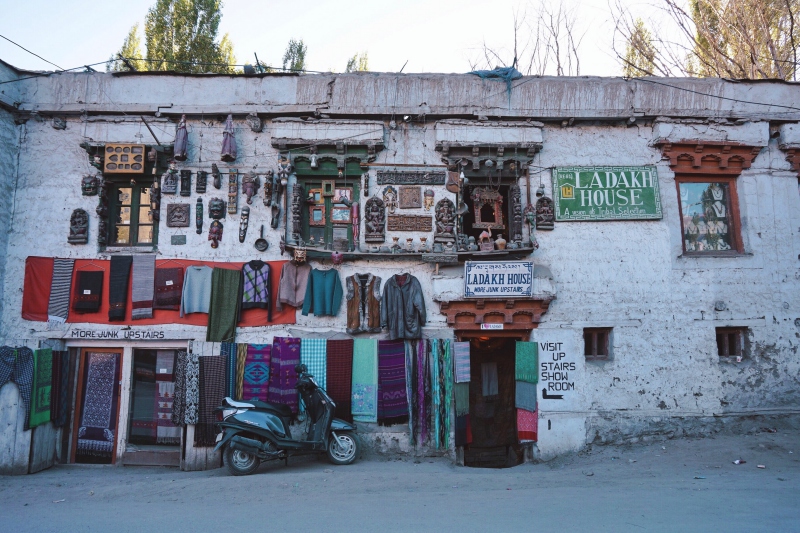
Inner Line Permit
If you intend to visit Nubra Valley and Pangong Tso, you'll definitely need the Inner Line Permit. It's best to get it done at least 1-2 days before your trip to the above mentioned places. I heard there are agents doing the application for you in Main Bazaar. We were lucky to have our accommodation owner to do everything for us. We gave him our passports on the first day we arrived in Leh, and it took around a day to process and approve our application. We paid 460 INR per person.
DAY 5
Shanti Stupa | Magnetic Hills | Confluence at Nimmu | Lunar Landscapes | Lamayuru Monastery
The driver we found the previous day came at 7am to pick us up. Our agreed price after bargaining was 4000 INR for a full day tour, which I thought was a good offer. He didn't even charge extra when I told him I wanted to include Shanti Stupa in the itinerary. Check out the Ladakh Taxi Union rate list to know the estimated price you have to pay. The price is usually fixed to protect their drivers.
If you are coming from Srinagar, you can stop by Lamayuru on the way. Please remember to look for a Leh/Ladakhi taxi with a yellow plate that starts with JK 10 if you hire a driver in Srinagar.

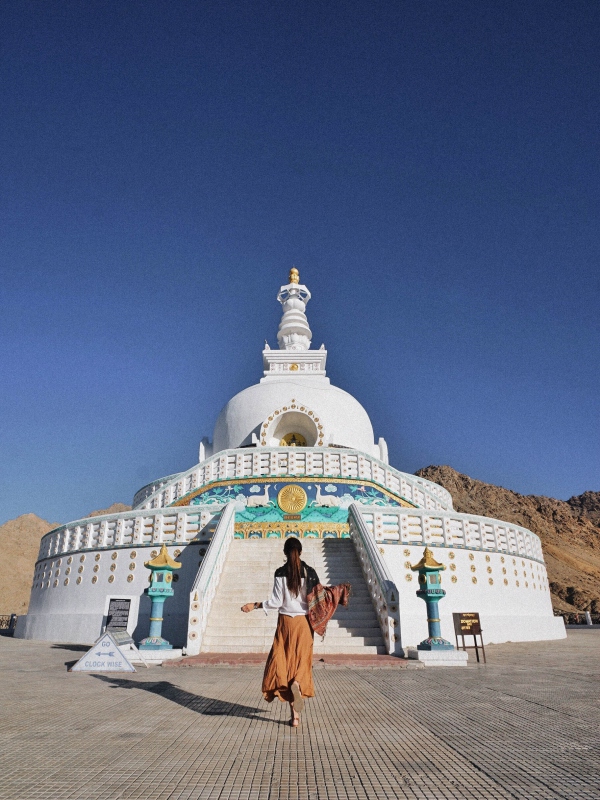 |
| Shanti Stupa |
Shanti Stupa is a Buddhist religion shrine built on a steep hill facing the Leh Palace. The construction was jointly done by the Japanese and Ladakhi Buddhists to mark the completion of 2500 years of Buddhism and to promote world peace.
Its size and location make this stupa unmistakably easy to spot. Located at an altitude of 4,267 meters above the sea level, it offers a 360 degree view of the city of Leh. It is open for visitors between 5am and 9pm.
We then set out on our journey towards Lamayuru. It's a long drive, but you'll enjoy all the nice views along the way.


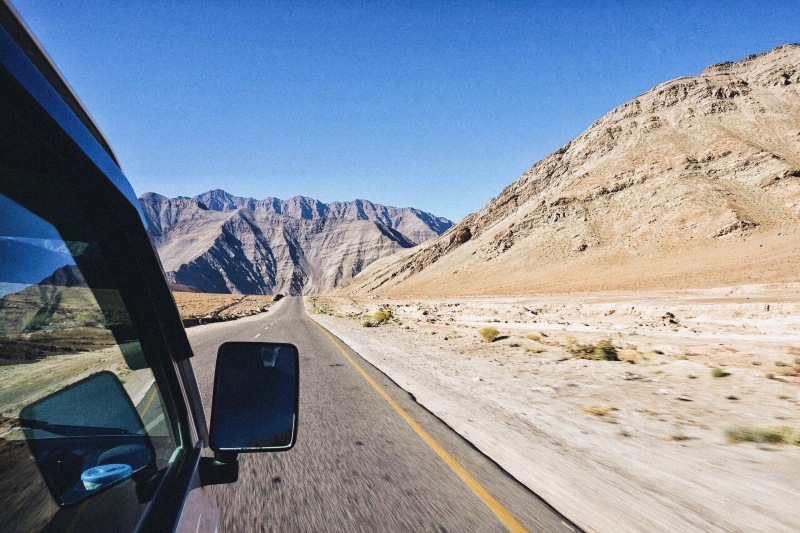
The first stop to see was the Magnetic Hill. Lying at a distance of around 30km from the town of Leh, the Magnetic Hill is marked by a yellow signboard which reads “The Phenomenon That Defies Gravity”. It also instructs you to park your vehicle in the box marked with a white point on the road, which is known as the Magnetic Road. When parked at the indicated spot, your vehicle will begin moving forward.


The widespread theory behind this is that the hill emits a great amount of magnetic energy, thereby pulling vehicles that are within its range towards it. However, some people do not believe this at all, and explains the gravity-defying phenomenon as an “optical illusion” which causes the downslope leading to the Magnetic Hill to appear like an upslope.
Whichever theory it is, I'm glad I got to experience this wonderful phenomenon!
Not long after Magnetic Hill, you'll come across this magical place in Nimmu. It is a beautiful valley that marks the confluence of the Indus River and Zanskar River. Indus river is originated from the great Himalayan ranges and Zanskar river originates from Zanskar ranges. Zanskar river is shiny blue in colour, on the other hand Indus looks a little green. Can you see the beautiful colours below?
 |
| Nimmu confluence |
Ladakhi Toilet
Like I said, it was a long drive, and I'm sure at some points you will need to use the toilet. However it is not easy to find public toilets in Ladakh in general. My driver stopped me at this 'public' toilet which has only holes in the ground, where you squat with your bottoms a few inches away from stuff left by others, literally.
At home, we're so used to flushing the toilet using water, but Ladakhi toilets are one type of dry-composting toilets that do not use water to take the waste somewhere else. Instead, it allows natural processes to rapidly break down the waste to produce compost that is later used as organic fertilizer to enrich the soil.
I swear it's not an easy job for foreigners when you have to answer nature's call on the road in Ladakh.
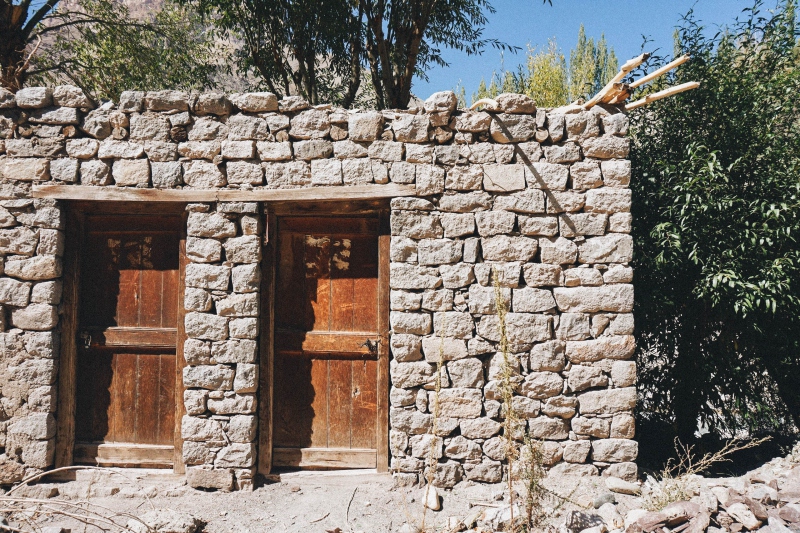 |
| Ladakhi toilet |
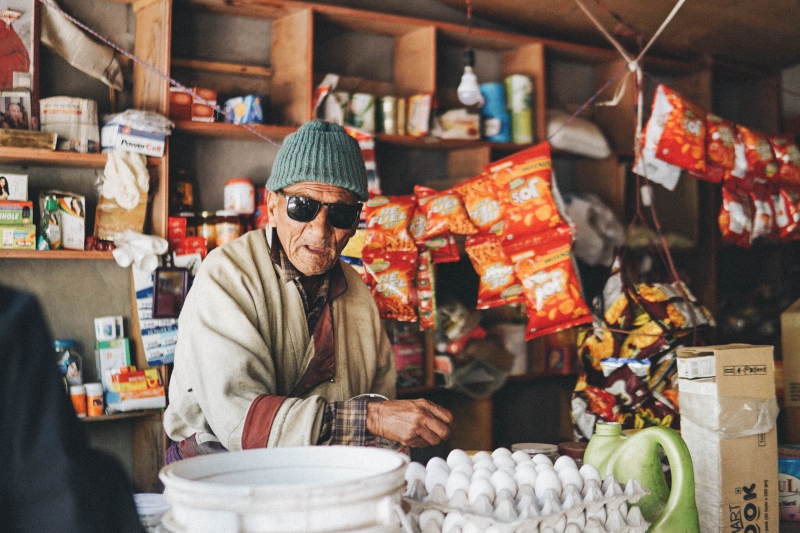 |
| Convenience store |
 |
| A lady selling snacks on the roadside |
After a 3 hour journey, we finally got to the Lunar Landscape, where you will see a moonlike landscape similar to lunar terrain. The yellow color of the land here is distinct in its appearance providing the feeling of being on a different planet.
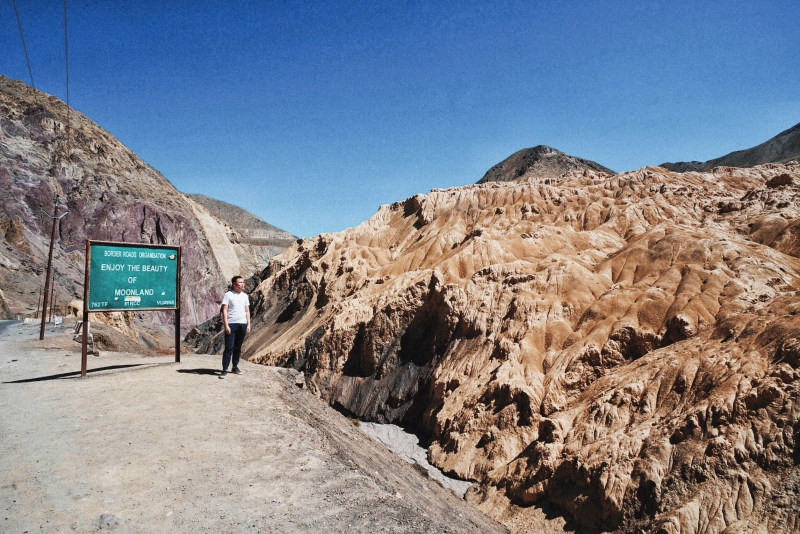
 |
| Lunar Landscape |

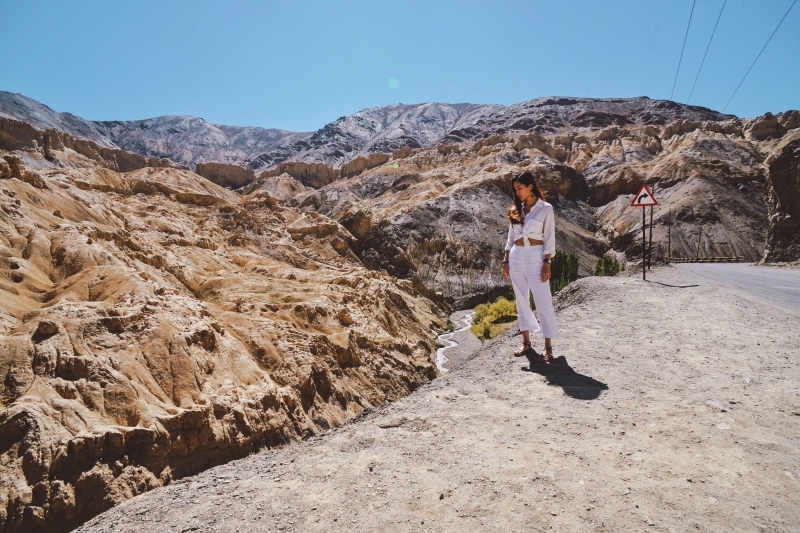
Driving further up, it's the magical legend of Lamayuru Monastery, which is perhaps one of the most intriguing places that you can see. It's considered to be one of the largest and oldest monasteries of Ladakh. The monastery is located on top of a barren hill (at 3500m) while the village, built in the same Tibetan/Ladakhi style with whitewashed walls, spills down the slopes.
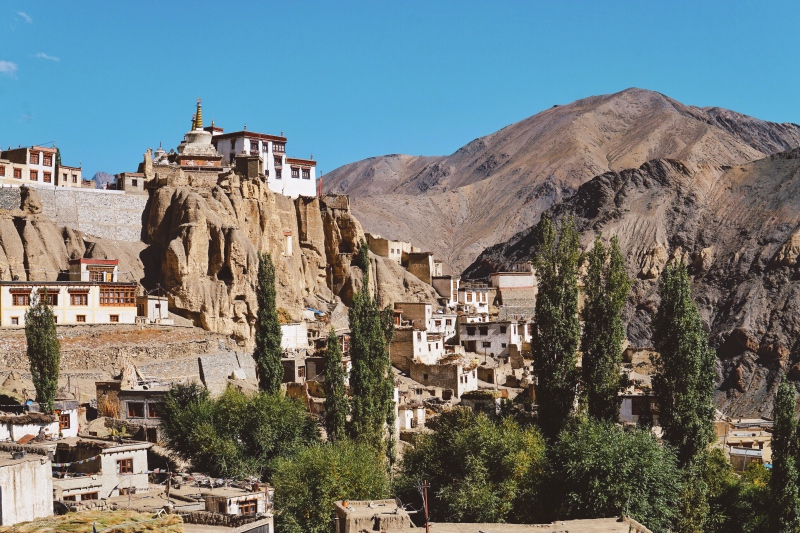 |
| Lamayuru |

 |
| A row of prayer wheels |

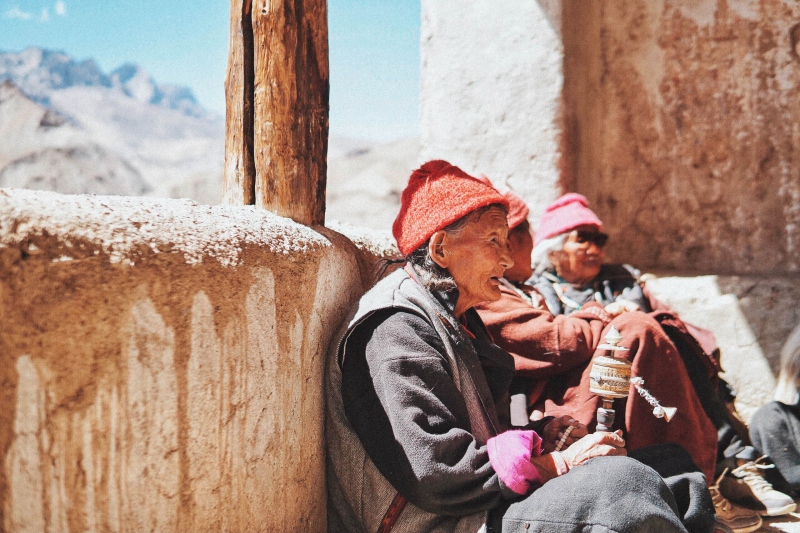 |
| An old lady spinning the prayer wheel |


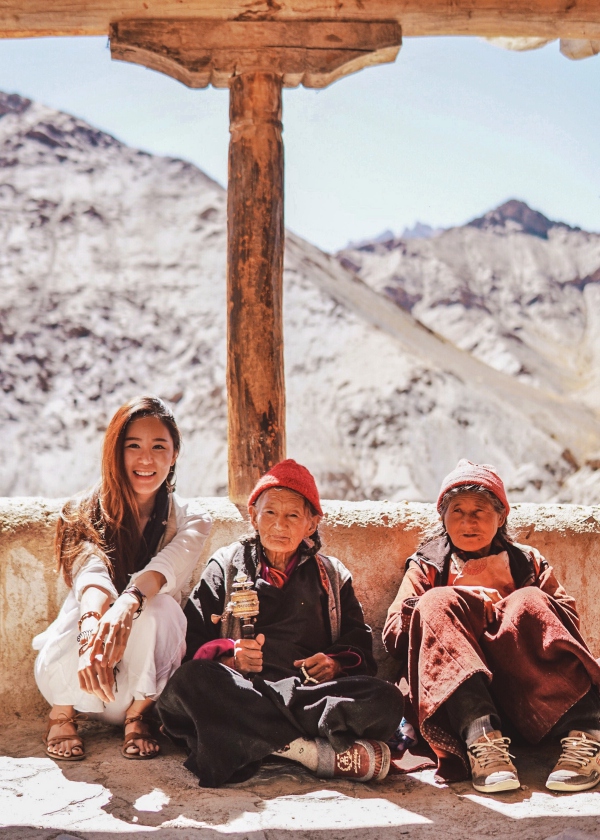
I like the fact that it was not touristy at all, only a few tourists were spotted in the surrounding area. I enjoyed so much walking around the Monastery, studying all the little details of their old architecture, looking down into the valleys from the top, watching all the children monks doing works, and observing how these religious old ladies were sitting at a corner spinning their prayer wheels together.
Not wanting to leave this place so soon, we decided to have our lunch nearby.
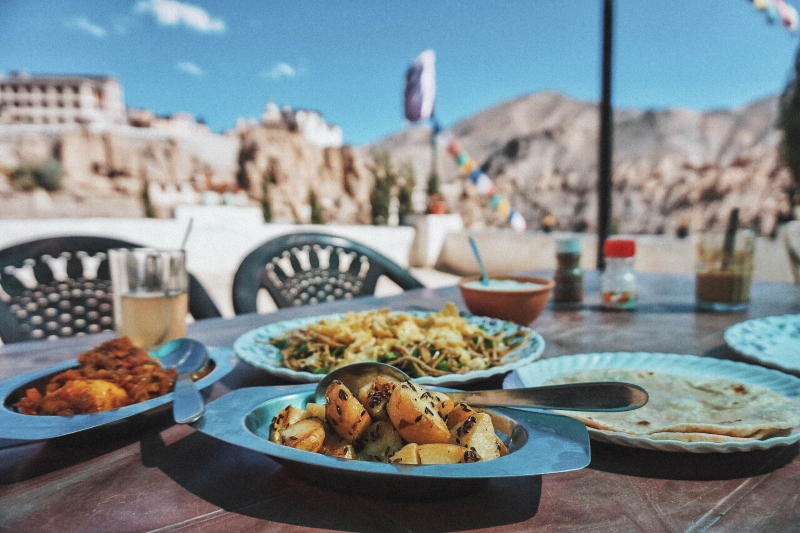 |
| Lunch with this perfect view |
We came to this hostel-restaurant that is facing the Lamayuru Monastery. Despite its excellent view and location, it was incredibly quiet with no customers, other than an old man sitting there spinning his prayer wheel, and a foreign young female backpacker reading at a corner. The menu was simple but I swear it was the most unforgettable meal I've had in India -
cool breeze, peace, total quietness with only sounds of the nature and the prayer wheels, and the absence of Internet/Wi-Fi made the whole experience 100% better.
For the first time I could indulge completely in nature with no distraction at all from the outside world. All I wanted to do was just sitting there and being part of nature. It was amazing and inspiring to learn that life can be as simple and happy as this.

After the lunch, we then returned to Leh. Again, it took around 3 hours to come back to our accommodation in Leh.
If your plan is to go to Leh from Srinagar like I mentioned earlier, you would need to stop a night either at Kargil or Lamayuru. I've never been to Kargil but I would definitely choose Lamayuru as a stopover because it is a perfect spot for you to take in all the peace while taking a break before resuming your journey to Leh.
DAY 6
Nubra Valley | Khardung La | Hunder sand dunes & camels | Diskit
Finally received our Inner Line Permit (refer above) and managed to make a trip to the main destination of our trip - Nubra Valley! You need to bring your passport and the permit with you as there will be check points/border security along the route.How to Reach Nubra Valley
The best way to reach Nubra Valley is by road as there aren't any train stations or airports situated in the region. The closest airport is in Leh. There are a few options to make a trip to Nubra Valley:
- Bus/Jeep - If you are looking to reach Diskit in Nubra Valley, you can consider public jeeps in Leh which are run by the state government (6-7 hour journey). They are just ordinary buses used by locals to travel around. You should keep your expectations in terms of comfort to zero. Apart from that, you will not be able to stop anywhere you'd like along the way. For getting around the valley, please note that bus services are incomplete.
- Shared taxi - You can get a seat in a local taxi which is normally run in the same manner as a local bus. You share the taxi fare with other riders.
- Private taxi - You hire a private driver to go with you all the way to Nubra Valley, and you will need him to bring you back to Leh again. You don't have to worry about his accommodation like I did, because he will find his own way.
- Motorbikes - A lot of Indian motorcycle enthusiasts love to use to option. Those who are unable to take their motorcycles to Leh can get one for rent. One can locate numerous bike rental shops in Leh or you can ask your hotel to arrange one for you.
After a long discussion with ST, we decided to hire a private taxi even though it is more expensive. We thought this is the best way to get to Nubra Valley because the valley is beautiful, so you can stop wherever you want, soak in the views and take your own time to enjoy the natural surroundings. Also, it is a more comfortable option for such a long ride on all the winding mountain roads. Take note that even though Diskit is at a distance of about 120 kilometers from Leh, a bus could take up to 7 hours to reach.
I personally would not recommend one to self-drive because roads are too dangerous and narrow. Also, your phone will be out of service as soon as you leave Leh. There is almost no mobile coverage here which will make it hard for you to use any GPS apps to find your way. Getting lost and trapped in the middle of the mountains is the last thing you want as there will probably be no one around to assist you.
We were lucky to have our host arrange a private taxi driver, Padma, to bring us on a 2-day road trip to Nubra Valley. Do not worry too much about your driver's accommodation. You only have to book your own. We were on a Toyota Innova, which is a better option for mountain roads. Sometimes if you are lucky, you'll be offered 10-20% discount off the price as shown on the list (refer above). Try to bargain with them.

After a cup of tea and coffee, we checked out, and departed with Padma, who came early at 7am to pick us up. We made sure to bring all the snacks, bread, and food with us so we wouldn't get hungry during the journey. Padma, like the usual people from Ladakh, was quiet and shy, but very nice to us. He made sure to clean his car properly before he came to pick us up.
Here in Ladakh, you will spot military officers, camps, and buses everywhere. Since Ladakh is a part of strategically important Jammu and Kashmir, the Indian military maintains a strong presence in the region.

 |
| A kid getting ready to go to school |
I cannot believe the amount of locals and even school kids I saw trying to hitch-hike directly on the roadside. Due to the fact that public transportation and vehicles are limited, most of them have to walk to school or work which could be on another side of the mountain.
It was a beautiful morning and the long journey started. I was already in awe minutes after we left Leh climbing up the mountain road towards Khardung La. After Leh, the valley and views are mostly on the left side.
Adventure at your own risk!
It's one of the most adventurous, nerve-wrecking, and mind-blowing experiences a human being can ever imagine!
I swear I was screaming in fear throughout the two-hour ride along the 39km long winding stretch before reaching Khardung La.
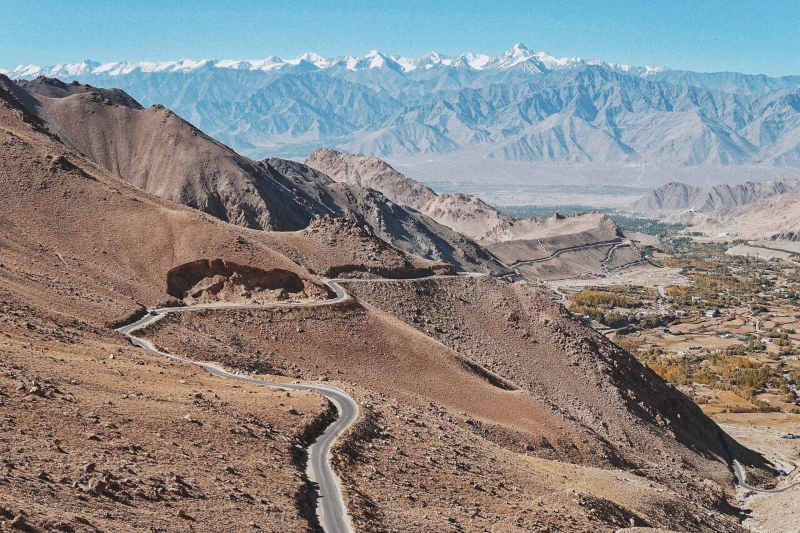
 |
| Trying to overtake military trucks ahead |



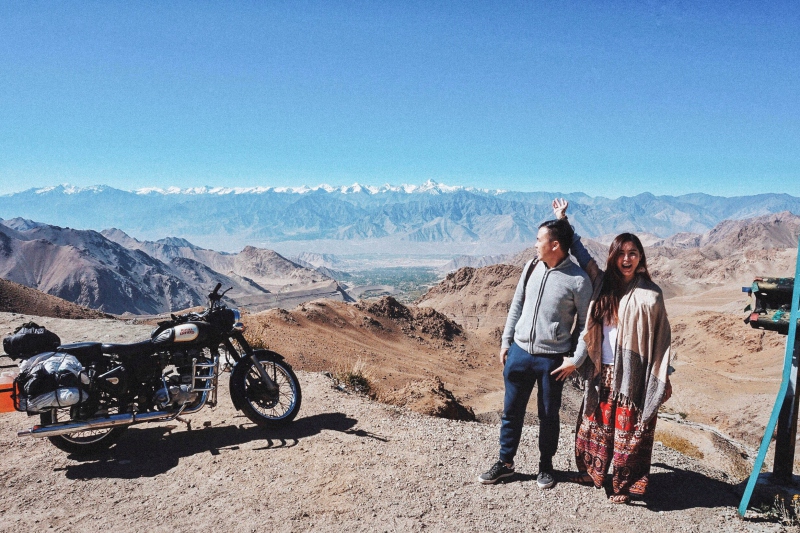 |
| That's not our bike, haha! |
Acute mountain sickness (AMS) can start to affect people over 2,400m. Khardung La Pass rises to well over double that, making those final kilometres absolutely agonising. It was a painful drive up.
It felt like a big accomplishment when you finally reached the top of Khardung La. We were finally on one of the highest motorable roads in the world! And I believe this will be the highest altitude in my life. *cries



It did not take long before we started having difficulty breathing. My head became really dizzy after 20 minutes of staying there. After realizing that the altitude sickness would get worse, we immediately jumped in the car and left. As we were descending, we slowly felt better.
This trail passes through remote areas, so you need to be prepared. Usually there are potential long travel delays due to traffic congestion on narrow one-lane sections, washouts, landslides and road accidents. We had a landslide blocking our way not long after we drove down. We had no choice but to stop the car and wait for the locals and army to shove those big rocks away. It took at least 30 minutes.
The drives are the spellbinding part of this trip that you will not forget!
Now after Khardung La, the valley is on your right side and it was a bliss of a drive! The views are MAGNIFICENT I could not use words to describe. Being tucked up in the lap of the Himalaya, all we could see were enigmatic culture and mesmerizing valleys with stunning rock formations.




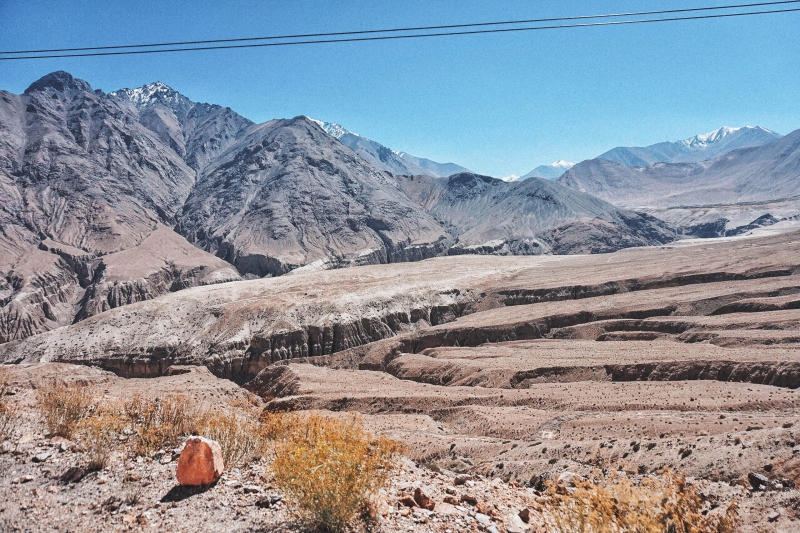




After around 3 hours, we went from high altitude never ending valleys to a stunning desert land, Hunder. I love how unique the landscape is - desert with a backdrop of the Nubra Valley mountains.
 |
| Hunder |
Padma first drove us to Diskit, where our booked accommodation was, before bringing us to the Hunder sand dunes to hang out with camels.
These double-humped Bactrian camels are natives of Mongolia in central Asia.



 |
| Home-cooked dinner prepared by our host |
DAY 7
Diskit Monastery | Pangong Tso (via Syok) | Chang La Pass | Leh
We did not plan to go to Pangong Tso at all today. Earlier, our plan was:
- Day 7: Diskit back to Leh (using the same road as the day before)
- Day 8: Leh to Pangong Tso, and back to Leh - which is a big challenge due to the unbelievably far journey
We knew it would be possible to go from Nubra Valley to Pangong Tso, via two different ways as mentioned by Vargis Khan:
- Wari La - could take up to 10-12 hours
- Syok - shorter but more risky than Wari La
HOWEVER, Padma, our very skilful and experienced driver that has been driving for years in the Himalayas in Ladakh, assured us that it would be totally fine to travel from Diskit to Pangong Tso via Syok, and back to Leh on the same day, which would be the BEST option for us to save more time, money, and effort to find another driver in Leh again. We would save a day in our trip! We agreed to his offer and topped up his allowance to make a trip to Pangong Tso with him.
We departed at 7am and stopped by the Diskit Monastery.
 |
| View from top of Diskit Monastery |
The main and unique attraction of Diskit Monastery is its gigantic statue of Buddha. This famous tourist attraction is considered as one of the oldest as well as the largest Buddhist centers in Ladakh.


Before continuing our drive into Syok, we stopped by a small restaurant to have a quick breakfast.
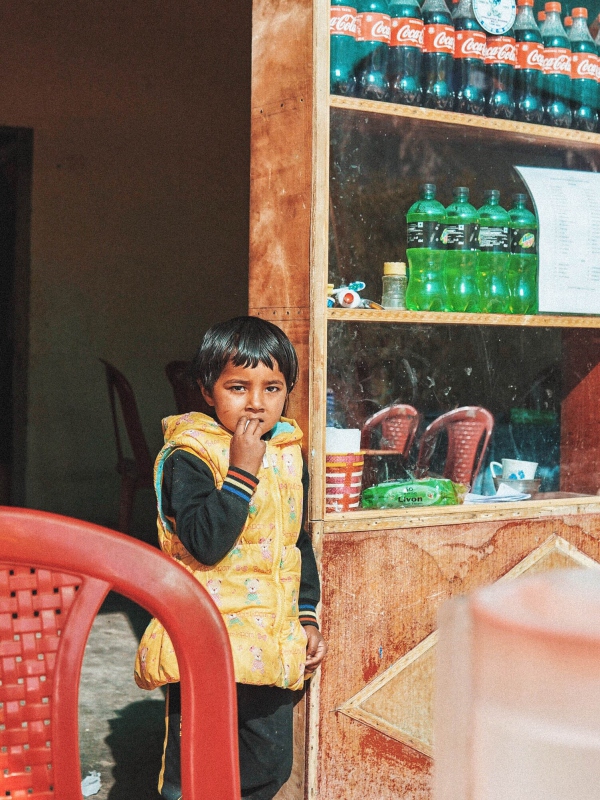

 |
| A breathtaking view next to the random breakfast place |
Driving into Syok, it was quite a concern to me at first due to the comment made by Vargis Khan. He mentioned that Syok is mostly just a broken dirt trail that runs right next to Shyok river. Sometimes if the water level in the river is high, road will even run under the water. However, Padma was really good and we did not have many difficulties conquering the road. Also, thank God we did not have to drive in the water. I cannot imagine self-driving here as a tourist. You would completely get lost and stranded because of the unclear roads.
Along the way, you will see local labours including ladies working under the sun doing road works and carrying big rocks. I even saw them working on the edge of the mountain with vehicles passing right next to them, which is really dangerous!
I was really inspired by Padma, our driver who was always so kind to hand them snacks and water, even though those are the last pack of chocolate and the last bottle of water left in the car, knowing the fact that it's almost impossible to find a building, a restaurant, or a shop along the journey. He showed us how to be selfless and kind to other people.
 |
| Padma giving away the water bottle we gave him. He did not even keep anything for himself. |
 |
| Syok river |
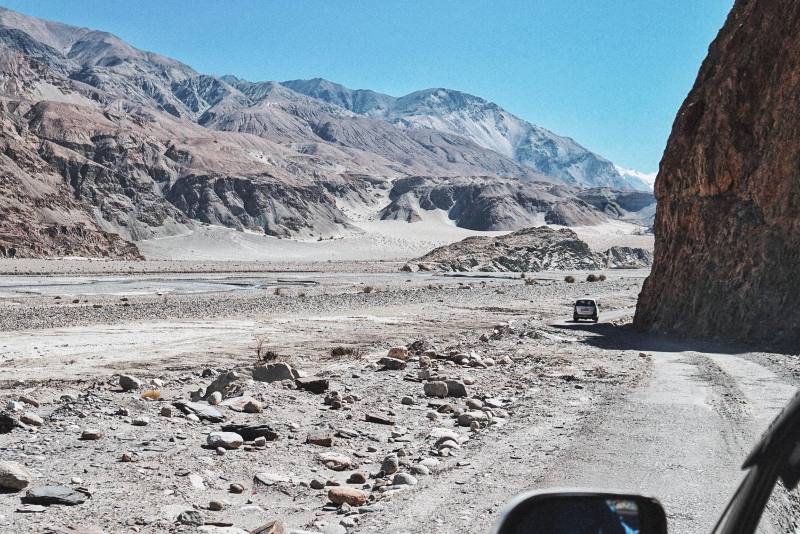 |
| Broken dirt trail which is unfair to be called a road |
 |
| The hypnotic beauty of Ladakh's ever changing majestic and alluring landscapes |



 |
| Durbuk |
 |
| Himalayan marmot (groundhog) |
The long awaited view of Pangong Tso appeared right in front of us after around an hour drive from Durbuk.
This lake became a hit after a movie called "3 Idiots" released in 2009, which featured its deep blue lake against the backdrop of mighty Himalayas barren grey mountains. A lot of travel enthusiasts started discovering the beauty of Ladakh and Pangong Tso.
The temperature is rather cold here in Pangong Tso. It is situated at a height of about 4,350 m (14,270 ft).
Be ready for your breath to be taken away! How is this place even real!
 |
| Pangong Tso |
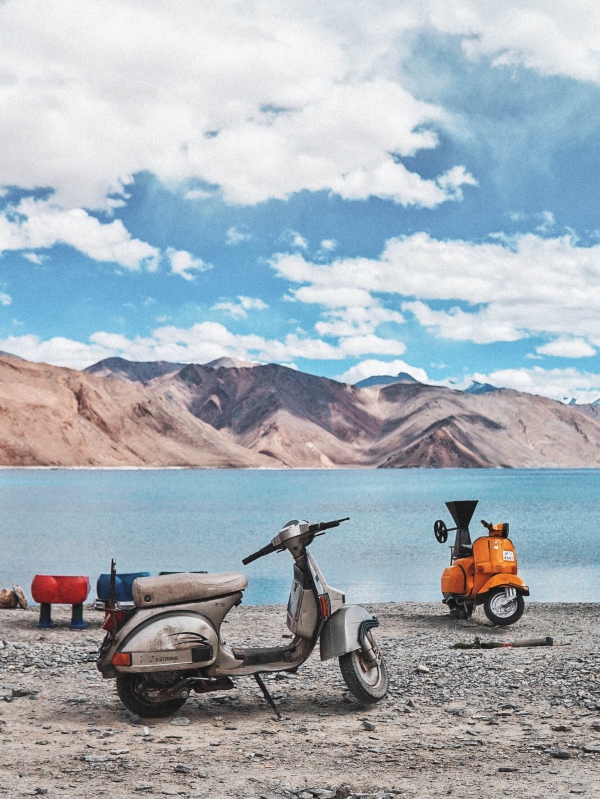

 |
| An old lady selling hot tea and cookies in the cold weather |
 |
| Prayer flags |
 |
| Lunch place in Pangong Tso |
We spent 2 hours in Pangong Tso until 3.30pm. Following our lunch, we left and set out on another long journey back to Leh. We used the Chang La road this time. It is great that we managed to use different roads and passes which allowed us to see more of Nubra Valley. Every drive was special and beautiful in its own way!
Chang La pass is claimed to be the second (or third?) highest motorable road in the world at 5,360m (17,590ft). To be honest, this is the scariest road that I personally have experienced. Driving down from the top along the incredibly narrow dirt road right next to the edge of mountain was harder than I imagined. It was so dangerous we even came across several crushed vehicles on the slope of hill that probably got thrown off the edge due to accidents (see picture below). Again, think twice if you want to drive here!
 |
| Dangerous high mountain roads |
 |
| A crushed vehicle thrown off the mountain road, which happened 2 hours before we passed by. The driver was dead according to the locals. |

 |
| The dog was so calm taking in the view while I was running for my life due to bad altitude sickness |

 |
| Roadwork labourers' shelters |
Padma the Best Driver in Town
Thanks to Padma's excellent driving skill, we reached Leh safely after a crazy 4-hour drive. For the past 2 days, we had learned so much from Padma about the roads, the valleys, the locals, their culture, history, and religion. It was interesting to learn how a natural disaster ruined their home many years ago, how Padma witnessed many deaths and carried all the dead bodies to help, how he and others became Buddhists and vegetarians since then. He also inspired me by demonstrating how in real life to be kind to other people, and sharing good values in human that everyone should acquire.
If you plan to travel to Ladakh and Nubra Valley, do not hesitate to contact him:
- Email address: padmatonyot7@gmail.com
- Mobile number: 9596 9837 74 / 9469 3775 82
As Internet is quite limited in Ladakh, I would suggest you to give him a call to make a booking. He is happy to customize and plan your itinerary. However, do not expect any unrealistic itinerary that covers ALL spots you want in a short time frame, it is really tiring for them to drive 10-12 hours everyday.
DAY 8
Leh | Ladakh Festival
On the last two days in Ladakh, we were staying in a different accommodation. It's not the best but it was okay. Compared with the first house which had a more spacious interior, this one was noisier due to the smaller rooms that all sit next to each other on the second floor. The walking distance to the Main Bazaar is also not as close.

Here in Ladakh, electricity is limited, so expect power cuts which are random and unpredictable. Most of the time during our stay, we did not have electricity, let alone Wi-Fi. Even the sim card we bought earlier in Jaipur did not work properly because of the mountains and poor reception area.
Not many houses here use air conditioning/heating system. In September, the temperature was quite low especially at night. We had to wear many layers of clothing to keep ourselves warm when sleeping.
On the last night, I had to skip taking shower because it was raining and the solar panels did not heat up the water. IT WAS FREEZING COLD.
Two things I loved about the house: Their breakfast and the host's daugther.

 |
| Host's daughter playing with my phone |
Now you know why this little girl is my favourite. She's adorrrrrrrable!
Today was a bonus because we had a last minute change of plan, which saved us an extra day in Ladakh! ST and I decided to just leisurely explore Leh after days of being on the road.
After the breakfast, the host brought us to her favourite scarf shop in Main Bazaar, which was located at a hidden corner behind all the big scarf and textile shops you will see on the main street in Main Bazaar. ST wanted to buy just an affordable scarf as a souvenir. I did not want to buy anything at all. However, it got really IRRESISTIBLE after learning and just touching different kinds of Pashmina and Cashmere fabrics. ST and I ended up spending 12,000 INR and 20,000 INR for seven Pashmina shawls, LOL. (Do not judge.)

Happily leaving the scarf shop, we walked around the town and sat down in a cafe sipping our hot tea and coffee. What a life!
We were also lucky to be here during the Ladakh Festival. It was a perfect thing to fit into our plan. We decided to check out the traditional music concert held in the Ladakh Arts and Media Organisation (LAMO) centre, which is located in the Old Town of Leh.
The Old Town has winding alleys between and beneath a series of old mudbrick Ladakhi houses and eroded chortens. The alleys themselves are a large part of the attraction.
 |
| Old Town of Leh |


 |
| Beautiful view from LAMO centre |
 |
| Traditional music concert |
We ended our day running back to the accommodation in the rain and grabbing local handmade snacks along the way. It was a simple and pleasant day!


DAY 9
Goodbye Ladakh
ST and I separated at the Leh airport and flew back to Malaysia and Dubai respectively. It was the most emotional thing ever. It had only been 9 days, but so much had happened and it felt like a dream, a class lesson that I can never acquire by going to school.
'What is your most unforgettable travel experience?'
'India - Ladakh.'

__________
Main Reference for Trip Planning
Accommodation:
Booking.com - Click to earn 10% back!- Leh: Adu's Eternal Comfort (HIGHLY RECOMMENDED!)
- Dsikit: Olgok Guest House
Airbnb - Click to earn travel credit!
Expenses (2 pax):
- Accommodation: MYR 758
- Transportation: MYR1,367
- Food: 6,959 INR ≈ MYR 430
- Entrance tickets: 3,480 INR ≈ MYR 215
- Inner Line Permit: 920 INR ≈ MYR 57
- SIM Card: 400 INR ≈ MYR 25
- Tips: 110 INR ≈ MYR 7
AVERAGE PER PERSON: MYR 1,430 (Flight tickets and souvenirs excluded)
10 comments
you are so great !!!!
ReplyDeleteI love you much!!!
Thanks for sharing your Ladakh trip. Such a priceless experience and the beauty, awesome. A life changer.
ReplyDeleteMy pleasure! It was an incredible experience! :)
DeleteHow I wish I was there with you guys. Your photo with locals sitting and ST photo with camel is story-feel
ReplyDeleteThank you! :D
DeleteWhat camera did you bring for your trip? The photos are amazing!
ReplyDeleteI have been to Ladakh n after seeing your IG pictures I just read your blog to revisit Ladakh with your view and experience and damn...while reading it felt I m traveling there with u guys again. This article has given me goal to revisit laddkh as soon as possible.
ReplyDeleteLadakh looks a lot like Bhutan. I’m thinking to hire local tour guide + driver to explore this place. Then as for Taj Mahal, I don’t think my partner can tahan those stress you been through and he will probably scold me bring him to India. That one I think I will hire local guide + driver as well. I’m still thinking which city should I fly into India to visit Taj Mahal before Lakadh.
ReplyDeleteBhutan is mostly covered with trees and forests. Ladakh is more about hight altitude barren mountains.
DeleteYou can fly into Delhi if you want to see Taj Mahal.
Dear Chu,
ReplyDeleteMay I know how to choose the pashmina shawl ? To know is real or fake ? Do u still recall which shop u went ? Thanks.